
05 Feb 2015 Three Ways Consumers Could Pay Exorbitantly Higher Premiums on the ObamaCare Exchanges in 2015
Executive Summary
Because of the way the subsidy mechanism of the ObamaCare exchanges functions, many exchange consumers who qualify for subsidies could end up paying exorbitantly higher premiums this year or be faced with scrambling to find a new policy that is cheaper. Even if they find a policy that is cheaper, it is no guarantee that they won’t still pay higher premiums than they did in 2014.
This study examines exchanges in 51 metropolitan areas. It finds that consumers in exchanges in over 40 areas who purchased the lowest-cost bronze plan in 2014, and keep that same plan in 2015, will pay higher premiums this year. On average, a 27-year-old single person earning $25,000 annually will pay $152 more per year, while a 57-year-old couple earning $50,000 annually will pay $862 more. In some places, though, they will pay exorbitantly more. In Jackson, Mississippi, for example, a 27-year-old will pay $1,168 more annually while a 57-year-old couple will pay $3,292 more.
The subsidy mechanism is based, in part, on the second-lowest cost silver premium on an exchange. How the price of that policy changes from year to year will determine whether consumers receive smaller or larger subsidies. How the price of other exchange policies change relative to changes in the subsidy will determine whether consumers pay higher premiums.
For example, consumers who qualified for a subsidy in 2014 will see their subsidy decline in 2015 if they are on an exchange in which the price of the second-lowest cost silver plan declines. If they also have a policy that has increased in price, then they will pay higher premiums. That is what happened in Jackson, Mississippi where, for a 27-year-old, the subsidy dropped by $83 per month and the cheapest bronze plan rose by $14 per month. That resulted in a monthly premium increase of $97, or about $1,168 annually.
Another way consumers on such exchanges could pay higher premiums is if they have a policy that decreased in price but did not decrease as much as the price of the second-lowest cost silver plan. That happened in New Hampshire. For a 57-year-old couple, the subsidy declined $163 per month while the bronze plan dropped $11 per month, resulting in a premium increase of $152 per month, or $1,824 annually.
Finally, it is even possible for consumers to pay higher premiums on an exchange in which the subsidies increased. Consumers on those exchanges who own a policy that increases more than the subsidy will pay higher premiums. In Miami, Florida, a 57-year-old couple with the cheapest bronze plan in 2014 is seeing a monthly premium increase of $129 ($1,548 annually) because the subsidy increased $18 per month but the cheapest bronze plan rose $147 per month.
Some “experts” have suggested that consumers shop around to lower their premiums. This study finds that comparison shopping would, in many cases, save consumers money. Yet in about 30 exchanges where consumers can reduce their premiums for 2015 by switching plans, they will still pay more than they did in 2014.
Introduction
Exchange consumers who auto-enrolled for 2015 in the same plan they had in 2014 could be in for a rude shock when their first insurance bill arrives. Thanks to the subsidy mechanism for the ObamaCare exchanges, many consumers are at risk of seeing their premiums increase precipitously.
Under ObamaCare, a person who purchases insurance on an exchange will be eligible for a subsidy if his annual income is between 138 percent of the federal poverty level ($16,105 for an individual) and 400 percent FPL ($46,680), provided he resides in a state that has expanded its Medicaid program. If he resides in a state that has not expanded its Medicaid program, he will be eligible for a subsidy if his income is between 100 percent FPL ($11,670) and 400 percent FPL. The subsidy formula is the price of the second-lowest cost silver plan on the exchange minus the “applicable percentage.” The applicable percentage is the percentage of income that one must pay toward his or her insurance before qualifying for a premium subsidy on an exchange. The applicable percentage is based on a sliding scale, starting at two percent for those with incomes at 100 percent or 138 FPL, and rising to 9.5 percent for those with incomes at 400 percent FPL. So, if the second-lowest cost silver plan is $2,500 annually and the dollar amount of an individual’s applicable percentage is $1,500, he or she qualifies for a premium subsidy of $1,000.
However, if the price of the second-lowest cost silver plan drops in the following year to $2,000, that same individual will see his or her subsidy fall to $500. If the plan that he chose did not fall by an equivalent $500, he or she will pay a higher premium.
About 70 new insurers entered the exchanges this year, and many of them offered plans with premiums that were lower than what was available on the exchange in 2014.1 As a result, the premium of the second-lowest cost silver plan has dropped on many exchanges.
In late October 2014, an article ran in the Denver Post stating that consumers in the Colorado exchange relying on subsidies “will see their share of premiums rise an average of 77 percent next year if they keep the same plans, according to the state’s preliminary analysis.”2 On average, a consumer could see his or her premiums rise from $161.79 a month to $281.01 a month. The article explained that “competition in the marketplace among insurance carriers led to a widespread and significant drop in the index premium, which the ACA defines as the price of the second-lowest cost silver, or mid-level, health plan in any given geographic area… A plunging premium for the benchmark plan means that the [subsidies] offered individuals and families also plunge.”3
This study examines how the subsidy mechanism has affected the premiums of consumers in the exchanges of large metropolitan areas in 50 states and Washington, D.C. It examines the impact the subsidy mechanism will have on a 27-year-old single person earning $25,000 annually and a 57-year-old couple earning $50,000 annually.
This study finds that there are three ways that consumers who did not change plans for 2015 could end up paying more. First, consumers who qualified for a subsidy in 2014 will see their subsidy decline in 2015 if they are on an exchange in which the price of the second-lowest cost silver plan declines. If they also own a policy that has increased in price, then they will see higher premiums. So, for example, suppose that a drop in the price of the second-lowest cost plan caused an individual’s subsidy to decline by $20 per month. If that individual owns a plan that increased by $10 per month, his total premium costs will increase by $30 per month.
Second, consumers who saw their subsidies drop because of a decline in the price of the second-lowest cost silver plan, and who owned policies that also declined in price but did not decline as much as their subsidies, will also pay higher premiums. Again, suppose that a drop in the price of the second-lowest cost silver plan caused an individual’s subsidy to drop by $20 per month. If the plan that individual owns decreased in price by only $5 per month, then his total premium costs will increase by $15 per month.
Finally, it is even possible for consumers to pay higher premiums on an exchange if the subsidy increased because the price of the second-lowest cost silver plan increased. Consumers on those exchanges who own a policy that increases in price more than the subsidy increases will pay higher premiums. Let’s assume that the price of the second-lowest cost plan increased so that an individual’s subsidy grew by $10 per month. However, if said individual owned a policy that increased by $20 a month, his total premiums costs will increase by $10 per month.
This study also examines whether consumers could pay the same premiums they did in 2014 by switching to a cheaper plan in 2015. While doing this could save some consumers money, switching to the lowest-cost plan could also still cost more than what consumers paid in 2014 if they live in the metropolitan areas of about 30 states.
Decline in the Price of Silver
Summary Tables 1 and 2 show how the second-lowest cost silver plans and subsidies changed in various exchanges from 2014 to 2015. (For all of the full tables, see the Appendix at the end of the study.)
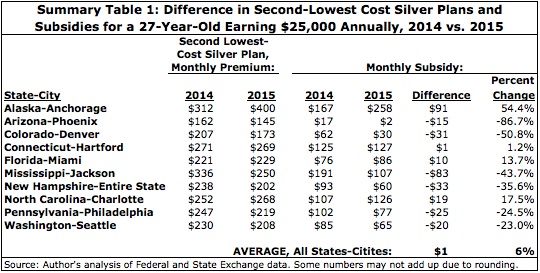
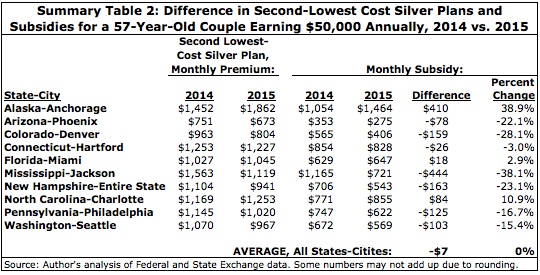
Overall, the second-lowest cost silver premium plan decreased in 19 exchanges for a 27-year-old making $25,000 annually, and it decreased in 22 exchanges for a 57-year-old couple earning $50,000 annually. In some states, the decreases were small, resulting in minimal declines in the subsidies. In Phoenix, Arizona, for example, the drop in price of the silver plan caused monthly subsidies to drop by only $15 a month for a 27-year-old. In Hartford, Connecticut, the decrease was only $26 a month for a 57-year-old couple.
In other areas, though, the declines are substantial. The worst is Jackson, Mississippi, where the silver plan declined over 43 percent for a 27-year-old and 38 percent for a 57-year-old couple. That resulted in a subsidy decline of $83 a month for a 27-year-old and $444 for a 57-year-old couple. Consumers in those areas who keep plans with prices that either remained the same or increased versus 2014 will see substantial increases in their premiums.
In the majority of exchanges, the second-lowest cost silver plan increased, resulting in higher subsidies. Consumers in Anchorage, Alaska experienced the biggest increase, with subsidies rising $91 a month for a 27-year-old and $410 a month for a 57-year-old couple.
However, consumers are not necessarily immune from seeing their premiums increase even if they are in an exchange in which the price of the second-lowest cost silver plan rose.
Three Ways to Pay Higher Premiums
As noted above, there are three categories under which an exchange consumer who keeps the same plan he or she purchased in 2014 will pay higher premiums in 2015. To examine these cases, this study looks at how the second-lowest cost silver plans interacted with the 2014 lowest-cost bronze plan, assuming that the consumer who purchased that bronze plan in 2014 keeps it in 2015. Table 3 shows which metropolitan areas fall into the three categories for a 27-year-old single person. (For a 57-year-old couple, see Table 4 in the Appendix.)
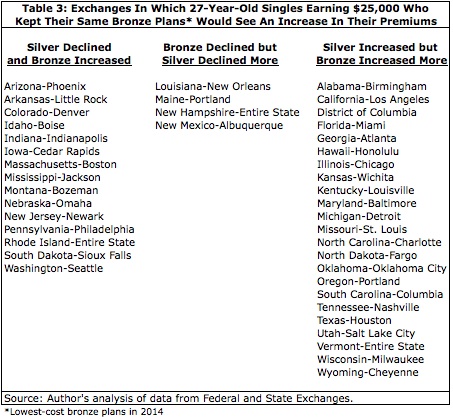
The exchanges in 42 areas fall into one of those categories. For a 57-year-old couple earning $50,000 annually, 43 exchanges fall into one of those categories. Thus, consumers who purchased the cheapest bronze plan in 2014 on those exchanges and keep that plan for 2015 could be in for a substantial premium hike.
Summary Tables 5 and 6 show how much consumers who purchased the cheapest bronze plan in 2014 will pay if they keep that plan for 2015. On average, 27-year-olds will pay $13 more in premiums monthly if they keep the bronze plan and about $152 more annually. A 57-year-old couple will pay, on average, $68 more a month and $812 more annually.
In some exchanges, consumers will pay less. Anchorage, Alaska showed the most improvement, with 27-year-olds who keep their bronze plans saving $237 annually and 57-year-old couples saving $984 annually. However, such savings occurred in the exchanges of only nine metropolitan areas for 27-year-olds and eight for 57-year-old couples.
In all other exchanges, consumers will pay more—in some cases exorbitantly more. In 26 areas, 27-year-olds will pay at least $100 more annually, and in 12 areas they will pay at least $300 more. The worst exchange in terms of paying more is Jackson, Mississippi, where a seven percent increase in the 2014 cheapest bronze plan and a nearly 44 percent decrease in the subsidy resulted in an annual premium increase of $1,168 annually.
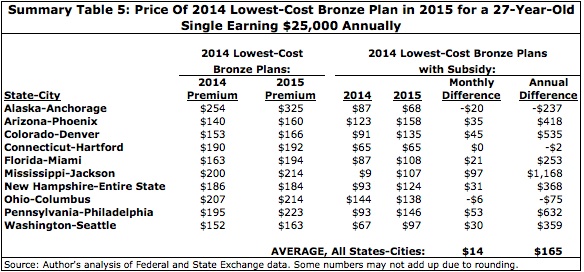
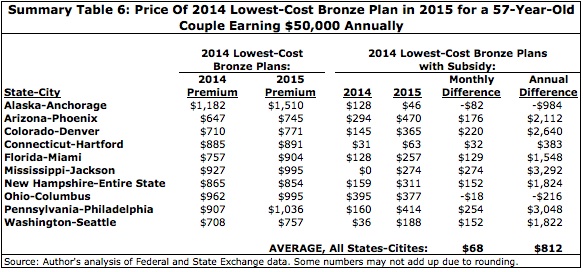
For a 57-year-old couple earning $50,000 a year, the worst area for paying more is also Jackson, Mississippi, where they will pay an additional $3,292 in 2015 if they keep the same bronze plan. Philadelphia, Pennsylvania wasn’t far behind with a premium increase of $3,048. In 36 exchanges, a 57-year-old couple will pay at least $500 more annually. In 16 exchanges, they will pay at least $1,000 more.
Change Plans?
Some policy analysts on the left have suggested shopping for a new plan as a way to avoid premium increases. “Consumers are ‘largely protected if they’re willing to switch plans,’ said Larry Levitt, vice president of special initiatives at the Kaiser Family Foundation.”4 This study examines how consumers would fare by switching plans. First, it looks at how much money consumers who chose the cheapest bronze plan in 2014 will save by switching to what is the cheapest bronze plan in 2015. Second, it looks at whether switching to the cheapest bronze plan saves enough so that consumers are paying no more than they were in 2014. Summary Tables 7 and 8 show how much consumers will save by switching to the lowest-cost bronze plan in 2015.
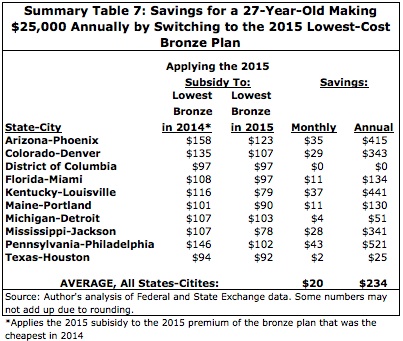
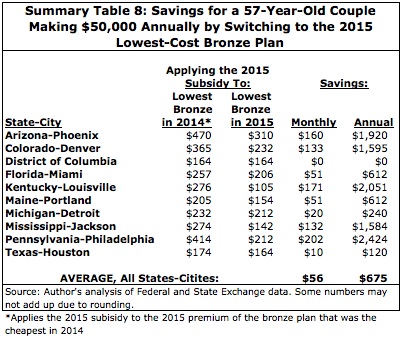
Fortunately, savings can be realized in all of the other areas. Some of the savings, such as those in Detroit, Michigan or Houston, Texas, are meager. But others, such as in Phoenix, Arizona, Louisville, Kentucky and Philadelphia, Pennsylvania are quite large. In all, there are 21 areas in which 27-year-olds can save at least $100 annually by switching to the lowest-cost bronze plan for 2015. There are also 21 areas in which 57-year-old couples can save at least $500 by doing the same.
But are consumers able to save enough by switching so that they will pay no more (or even less) than they did in 2014? To answer that, this study examines the 42 states in which consumers can achieve savings by switching to the lowest-cost bronze plan for 2015. It compares the cost of the lowest-cost bronze plan with a subsidy in 2014 to the lowest-cost bronze plan with a subsidy in 2015. The results are shown in Summary Tables 9 and 10.
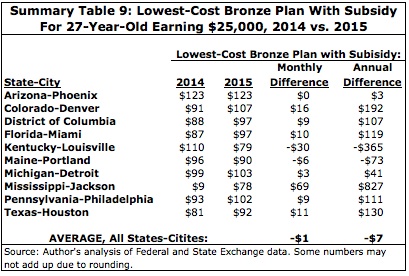
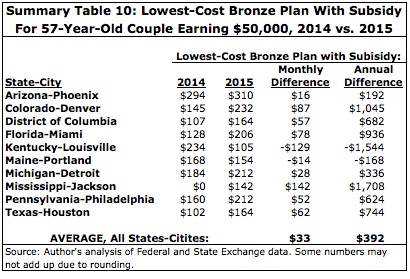
For 27-year-olds, there are 29 exchanges in which consumers will pay more in 2015 than they did in 2014 even after switching to the lowest-cost bronze plan for 2015. There are 33 such exchanges for 57-year-old couples.
In a few areas such as Louisville, Kentucky and Portland, Maine, consumers are able to pay less than they did in 2014. But more typical is the situation found in the District of Columbia in which a 27-year-old will pay $119 more annually than he or she did in 2014 and a 57-year-old couple will pay $682 more. Overall, in 16 exchanges, 27-year-olds who switched to the lowest-cost bronze plan in 2015 will pay at least $100 more than they paid in 2014, and 57-year-old couples will pay at least $500 more.
While switching bronze plans in most exchanges will save consumers money over keeping their current bronze plan, in the majority of exchanges they will still pay more than they did in 2014.
Rube Goldberg
The subsidy mechanism for the ObamaCare exchanges is a Rube Goldberg contraption —a complicated device constructed to do something simple that often has unforeseen consequences. The subsidy mechanism is a relatively complicated formula designed for the simple purpose of supplying people who qualify with subsidies to help pay for health insurance. Since it is based on the price of the second-lowest cost silver plan, it is inherently unstable as the price of that plan can shift considerably from year to year. As a result, exchange consumers will often face much higher premiums if their subsidies either decline or fail to maintain pace with increases in the plans they own.
Many exchange consumers will be faced with the difficult dilemma of either adjusting their personal budgets to accommodate higher premiums or choosing a different and cheaper plan they can more easily afford. However, consumers who choose the latter option will face the hassle involved in switching plans on the exchange, such as paying higher out-of-pocket costs or adapting to different networks of physicians and hospitals. Many exchange consumers have already expressed dissatisfaction with the “narrow networks” of most exchange plans that often make it difficult if not impossible for them to continue visiting physicians that they have been seeing for years. The subsidy mechanism increases that anxiety for the consumer.
These difficulties would diminish if the second-lowest cost silver plans increased every year and kept pace with the increases in other plans. That way, the subsidies would increase enough that consumers would not have to face substantial premium increases. The drawback to that, however, is that the federal government—i.e., taxpayers—will receive an ever-increasing bill for exchange subsidies.
Ultimately, the subsidy mechanism results in a no-win situation. Either consumers get hit in the pocketbook or the taxpayers do.
David Hogberg, Ph. D., is senior fellow for health care policy at the National Center for Public Policy Research.
Data Sources:
Federal Exchanges: http://www.healthcare.gov
State Exchanges:
California: https://v.calheers.ca.gov/apspahbx/ahbxanonym.portal?_nfpb=true&_st=&_nfls=false
&_pageLabel=previewPlanPage&_ga=1.221751960.1862996711.1420736760#
Colorado: http://planfinder.connectforhealthco.com/
Connecticut: https://www.accesshealthct.com/AHCT/IndividualInformation.action
https://www.accesshealthct.com/AHCT/FamilyInformation.action
District of Columbia: https://dchealthlink.com/calculator
https://dchealthlink.com/plan-info/health-plans
Hawaii: https://connecthawaii.com/web/guest/premium-assistance-calculator
Idaho: https://idahohix.yourhealthidaho.org/hix/preeligibility#/
Kentucky: https://kynect.ky.gov/PreScreening/YouandYourHouseHold
Maryland: https://secure.marylandhealthconnection.gov/AHCT/IndividualInformation.action
https://secure.marylandhealthconnection.gov/AHCT/FamilyInformation.action
Massachusetts: https://mahealthconnector.optum.com/individual/#
New York: https://nystateofhealth.ny.gov/individual
Rhode Island: http://www.healthsourceri.com/individuals-and-families/
Vermont: http://info.healthconnect.vermont.gov/healthplans#PCB
Washington State: https://www.wahealthplanfinder.org/HBEWeb/Annon_DisplayHomePage.action
Appendix
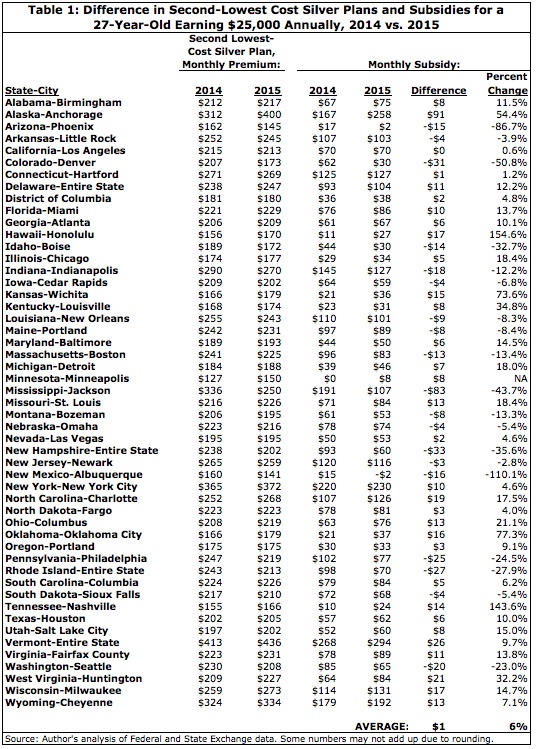
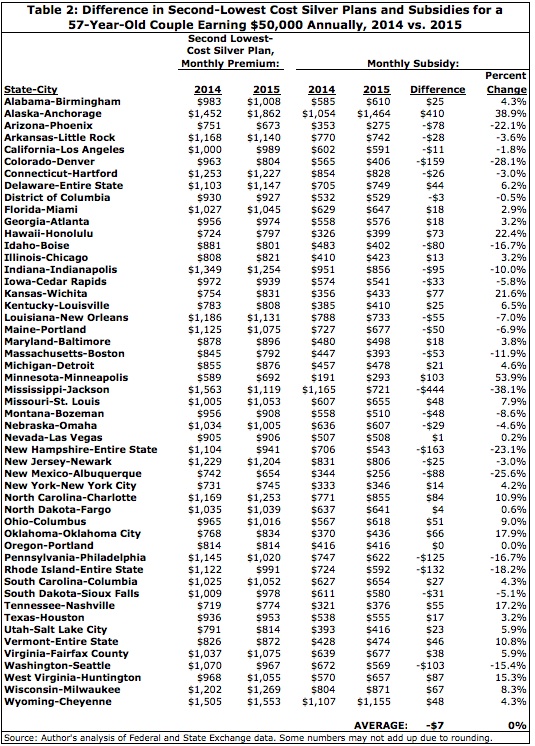

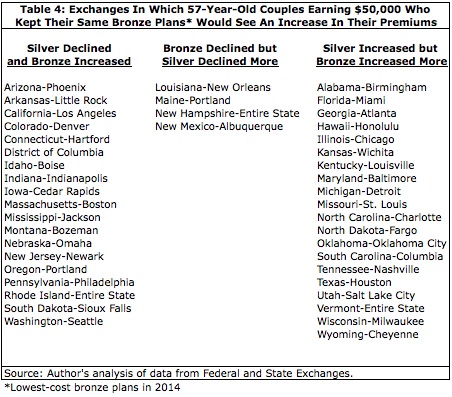
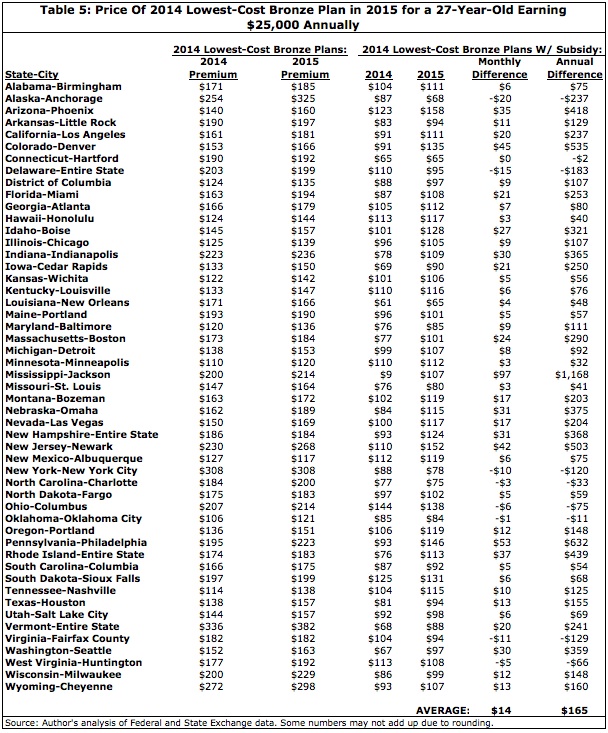
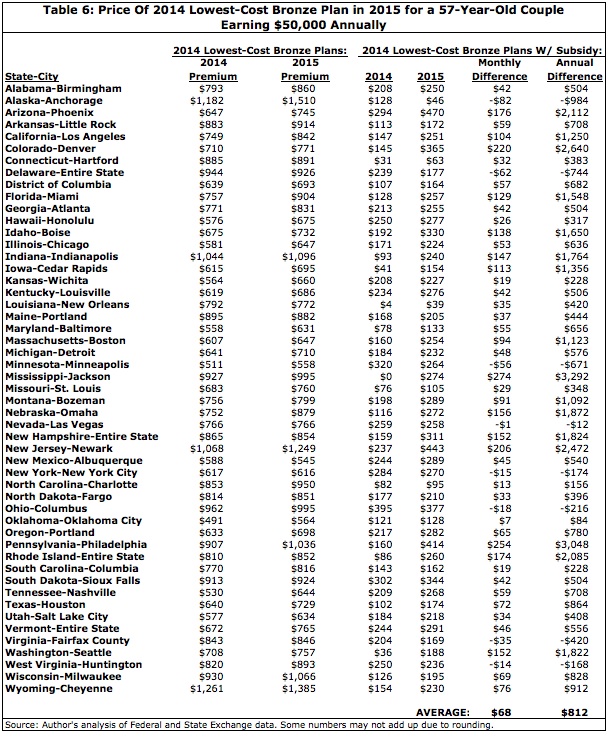
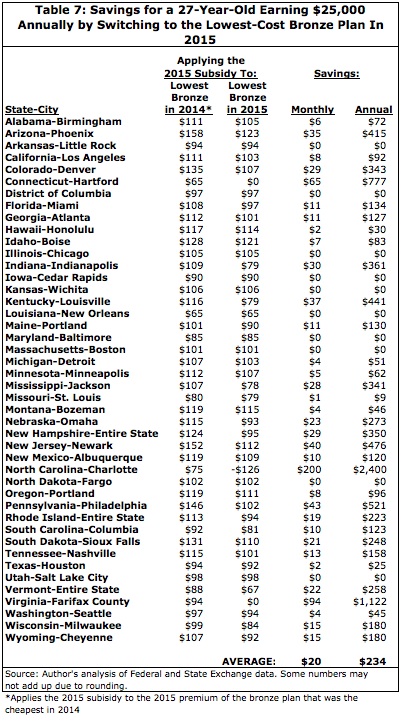
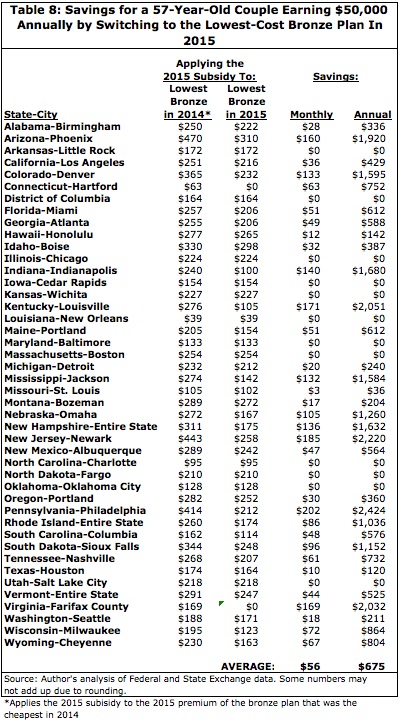
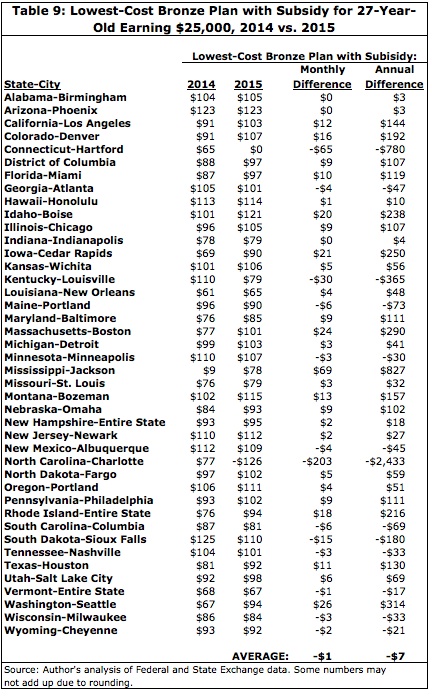
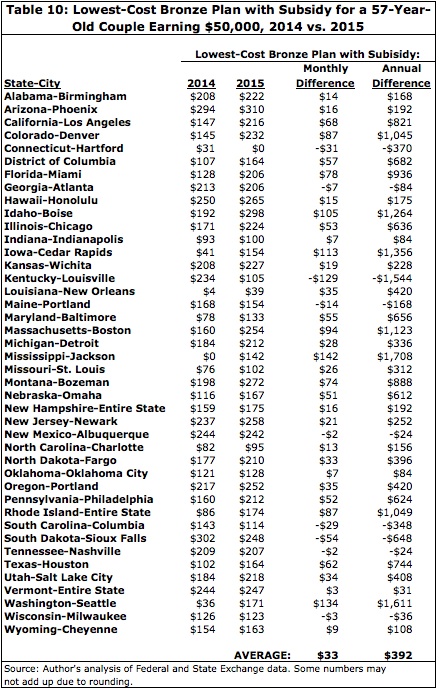
1 Department of Health and Human Services: Office of the Assistant Secretary for Planning and Evaluation, ASPE Issue Brief by Munira Z. Gunja and Emily R. Gee, “Health Insurance Issuer Participation And New Entrants In The Health Insurance Marketplace In 2015,” September 23, 2014, at http://aspe.hhs.gov/health/reports/2014/NewEntrants/ib_NewEntrants.pdf (January 9, 2015).
2 Electa Draper, “Colorado health-insurance buyers may get smaller tax credits in 2015,” Denver Post, October 27, 2014, at http://www.denverpost.com/news/ci_26810814/colorado-health-insurance-buyers-may-get-smaller-tax?source=infinite (January 9, 2015).
3 Ibid.
4 Sam Baker, “If You Like Your Obamacare Plan, It’ll Cost You,” National Journal, August 5, 2014, at http://www.nationaljournal.com/health-care/if-you-like-your-obamacare-plan-it-ll-cost-you-20140805 (January 9, 2015).



